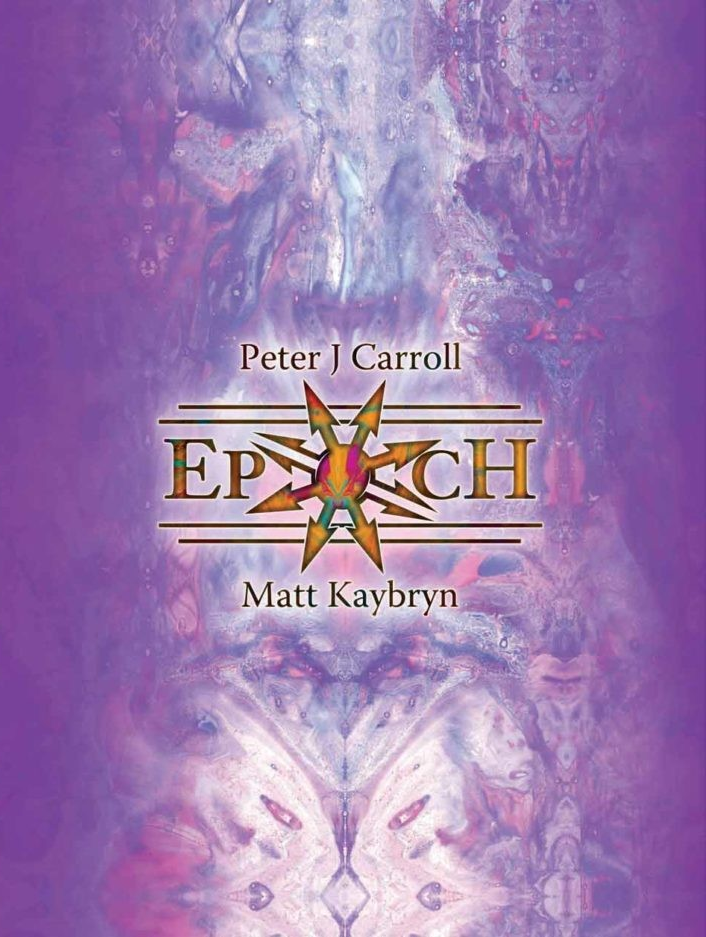
The Epoch – Hardbound Book (New Edition)
Plus Portals of Chaos Deck
By Peter Carroll and Matt Kaybryn


The Epoch – Hardbound Book (New Edition)
Plus Portals of Chaos Deck
By Peter Carroll and Matt Kaybryn

This gallery contains 2 photos.
Discover the enchanting blend of aromatherapy and practical magic in this transformative course. Beyond mere study, Aromagick invites you to explore the mystical realm where fragrance meets intuition. Here’s what awaits you: 1. Basic Principles of Aromagick: – Develop your … Continue reading

Chaos Magic For Skeptics
Carlos Atanes
Format: Softcover/135 pp.
ISBN: 978-1-914153-17-4
£14.99/US$22.00
Subjects: Chaos Magic
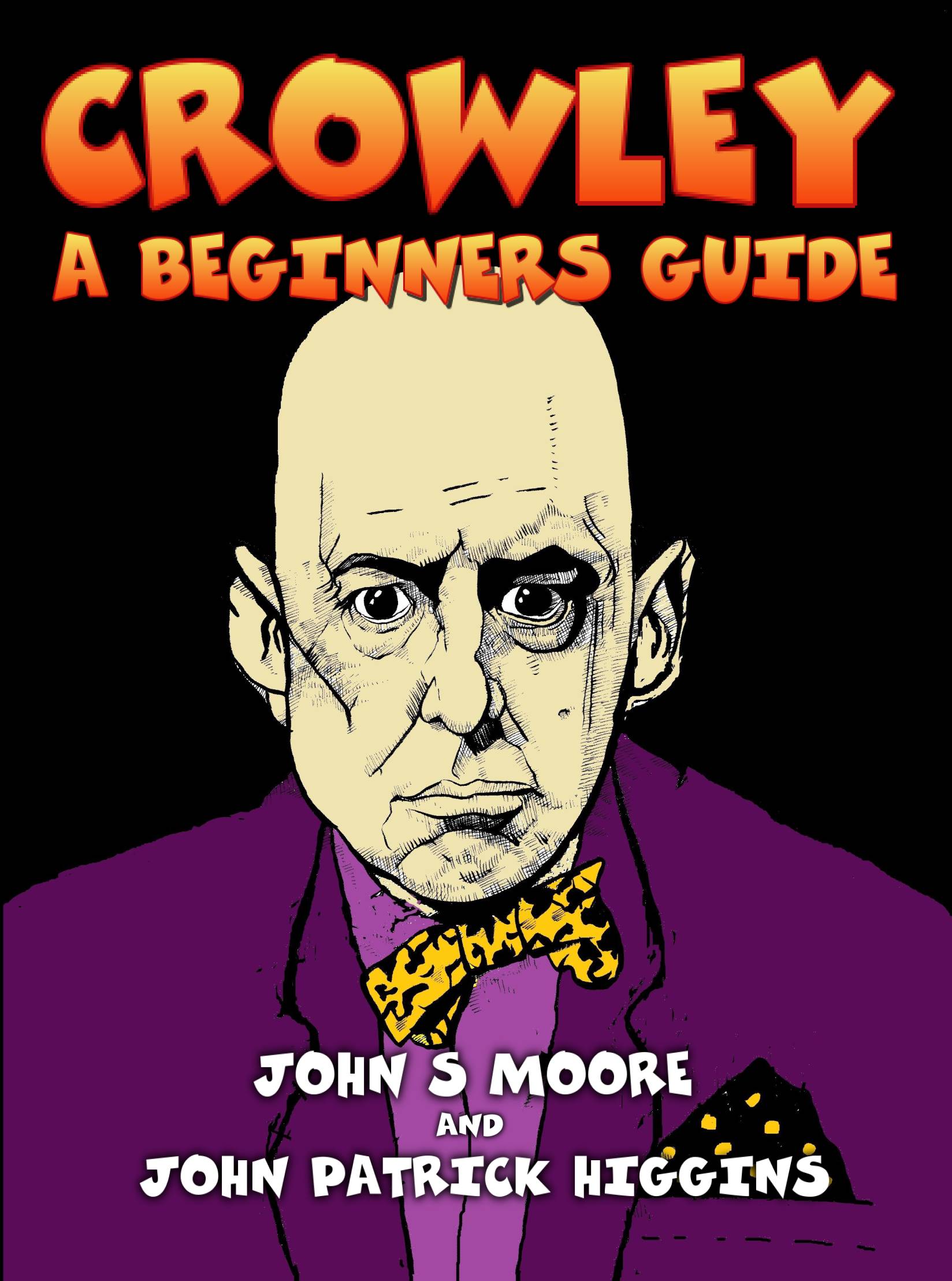
Crowley a beginners guide UK / £15.00
Crowley a beginners guide USA / US $22.00
Crowley, A Beginners Guide
John S. Moore & John Patrick Higgins
Format: Softcover/b/w Illustrated/154pp
ISBN: 978-1-906958-69-5
£15.00 /US $22.00
Subjects: Aleister Crowley/Thelema/Magick/Occult/Biography.
—–
“Do what thou wilt shall be the whole of the Law.”
Nearly seventy years after his death Aleister Crowley, the notorious Beast 666, is only just beginning to attract serious academic attention. Even so we would not expect to find him on any mainstream university courses; he is still too much associated with occultism. So, Crowley – A Beginners Guide is not your standard beginner’s guide.
“Let my servants be few & secret: they shall rule the many & the known.”
Readers may be surprised at the richness and complexity of his thought, as well as the extent of his influence. He needs background to be understood. Giving this opens fresh perspectives on much recent intellectual history.
Crowley – A Beginners Guide presents his main ideas in a straightforward and accessible format, with drawings and diagrams to place them in their historical context. It relates him to contemporary movements in art and scholarship. It describes his relationship to modernism and postmodernism, and his role in the counterculture of the sixties, as well as his continuing influence today. Interspersed are entertaining stories of his life and reputation.
Brilliantly illustrated by John Higgins, Crowley – A Beginners Guide, is a highly accessible guide to this fascinating, complex and controversial figure. It neither promotes nor condemns him, presenting hostile as well as favourable views of his character and achievement.
John S Moore is a freelance writer and independent scholar living in London. He is the author of Aleister Crowley: A Modern Master (Mandrake of Oxford, 2009) and Nietzsche – An Interpretation, (AuthorsOnline Ltd, 2011) and has written on Schopenhauer, Wittgenstein and Edward Bulwer-Lytton among others. More information at www.johnsmoore.co.uk
John Patrick Higgins is a writer and illustrator. He is the author of The Narwhal and Other Stories www.amazon.co.uk/Narwhal-other-stories-Patrick-Higgins ebook/dp/B007N6KJW8
He writes art criticism for various magazines and is Creative Director of Shot Glass Theatre Company www.culturenorthernireland.org/reviews/performing-arts/shot-glass. See also www.facebook.com
He lives in Belfast, which he continues to find extraordinary.
Read a review of Crowley A Beginners Guide from Magonia Review of Books pelicanist.blogspot.co.uk/2016/04/crowley-for-beginners.html

Click here for Kindle UK edition
As one might expect from such an articulate commentator, it also brings together practical how-to information, academic writing, and far reaching metaphysical exploration. This book touches on many different magical systems. Informed by the experiential approach of Chaos Magick and diving deep into the Mystery as presented through many traditions, this work explores:
Psychogeography and Magick
Transgressive bodywork
Our Vision of the End Times
Gender fluidity as spiritual process
The Boscastle Museum of Witchcraft
Zombies and the New Age movement
Buddhism meets Chaos Magick
Entheogenic magick, the law and social transformation
Mindfulness practice as the still point in the storm of chaos
The esoteric metaphysics of Pooh Bear, Tigger and Eeyore
…and much more!
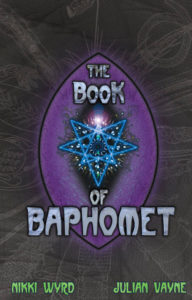
Click here for Kindle UK edition
Click here for Kindle USA edition
The Book of Baphomet
Julian Vayne & Nikki Wyrd
Format: Hardback/232 pp.
ISBN: 978-1-906958-46-6
£25.00 / US$3400
Subjects: Chaos Magick
–
You hold in your hands the material result of many years’ hard craft.
This Book contains some of the secrets of Life itself; or rather, the
occult deity of Life on Earth, Baphomet. Horned, vital, beautiful, awful, our aeons old Chaos Magick idol finds a name from the Knights Templar, then goes incognito through the Enlightenment (when flourished those great natural philosophers beloved of science historians), before emerging via devil worship and witchcraft into this era of Deep Ecology.
Darwin could have used a picture of Baphomet as his frontispiece, to
demonstrate the one flesh from which all species originate. Contacting
this Great Spirit, the anima mundi, allows access to a new way of
ordering the world, with fresh visions of how and why we could Live.
Here the authors weave strands from their lives into a rich tapestry
of images, which might give you a pointer or two towards your own
self-realisation, whilst amusing, entertaining, and instructing along
the way.
Revolution, evolution, leap beyond the apocalypse to the Now!
—
“An excellent read, consisting as it does of such a wealth of information, research, anecdote, experience and vision” – Peter J. Carroll
“It is a very fine book, in which your two voices form a harmonious whole, and which manages to interweave cosmology, history, science, autobiography and drugs in a very effective way which probably nobody else could have managed.” – Prof. Ronald Hutton
“I have finished the book and found nothing I would object to. It is most excellent. The so-called Occult world is full of really bad books that are a sad waste of trees. Yours shines amongst this dross.” – Ian Read
“Altered state of consciousness just reading it…”- Alistair Livingston
“A fascinating, poetic revisioning of the concept of deity for the 21st century”
– Levannah Morgan
Watch The Book Of Baphomet (Trailer)
vimeo.com/41602409
Check out
The Blog of Baphomet, a magickal dialogue between nature and culture.
theblogofbaphomet.com
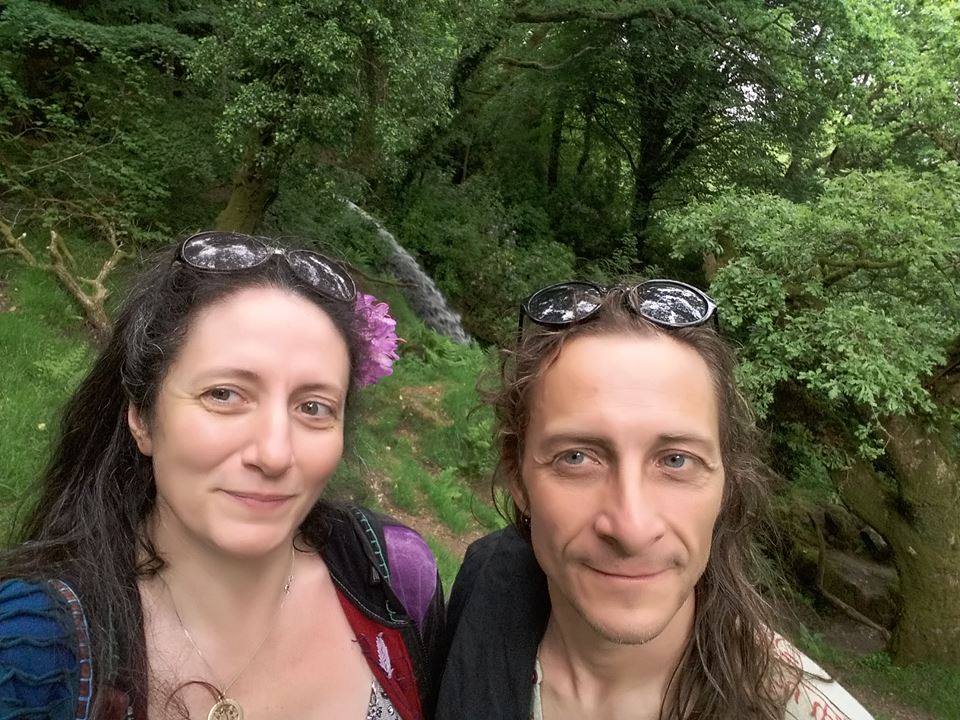
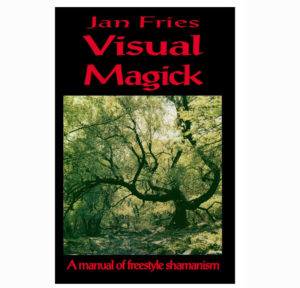
Visual Magick
A Manual of Freestyle Shamanism
Jan Fries
Format: Softcover
ISBN: 1869928571
£15.00 / US$24.00
Subjects: Sigil Magick/Runes/Shamanism/Chaos Magick
Buy UK Edition
Buy USA Edition
Suitable for all those inspired by such figures as Austin Spare and Aleister Crowley, and who feel the imperative to develop one’s own unique magick way. Visual Magick aims to build vision, imagination, and creative magick. It shows how magicians, witches, artists and therapists can improve visionary abilities, enhance imagination, activate the inner senses, and discover new modes of Trance awareness. The emphasis is on direct experience and the reader is asked to think, act, do, and enjoy as s/he wills.
More information
Visual Magick began as a small treatise on sigil Magick and automatic drawing circulated privately amongst members of the Maat network and is written for practising mind explorers of the unorthodox variety.
Review for Pentacle Magazine www.pentaclemagazine.org by Kate Hoolu
‘No matter what the medium, a talented priest can communicate … without preaching or didacticism. Art shows rather than tells. All great artists function as priests, whether they think of themselves as priests or not.’
If you are an eclectic magickian or shaman or have any interest in Austin Osman Spare, this is a book for you. Spare said, “All desire, whether for pleasure, knowledge, or power, that cannot find ‘natural’ expression, can by sigils and their formula find fulfilment from the subconscious”. This book is at least in part a modern view of the sigil magick that derives from AOS. But it is much, much more.
Fries has written on several subjects, including the Tao and Rune magick, but this work shows very good awareness and ability with Spare’s techniques, cross-fertilised with some of the more well-known methods of shamanism and his own innovations; hence the subheading.
Fries makes the important point that sigils can not only be designed by the operator (for whatever magickal purpose) but also RECEIVED from entities too… and in those cases, there is often a useful secret to be discovered within the sigil: “it should be noted that, while the sentience behind these sigils appears independent, their aesthetics are usually suited to the personality of the receiver. The best kind contains a blend of known and unknown…half-revealed and half-concealed”. This also stands as a beautifully short summary of perhaps what Aleister Crowley and the Book of the Law are about- obviously it is in AC’s writing style, but has so much more within… And Kenneth Grant’s work on the Tunnels of Set is supposedly largely based on received sigils.
Regardless of the occult debate about whether these received messages derive from a neurological or a non-human source, which is not within the scope of this review, it makes perfect sense for them to appear in this ‘mixed’ manner. If they were completely incomprehensible they would be ignored, and if they were completely ordinary and fully known already, then they would be un-remarkable and pass from consciousness as quickly as yesterday’s newspaper headlines. The half-unknown element makes them all the more tempting and interesting to the magickian, like a partly open door…
Avalanches of really good points are made by JF, which are eminently sensible, humorous and useful. Not for him is gibberish pontificating about very fine points of obscure theory; his stance is very much of the Chaos magician- ‘get off your ass, find what works, use it and keep trying new things and get out of your conditioned tunnel realities, rather than relying on dogmatic magickal techniques that often descend from book to book, unchanged and without ever being challenged. He makes the very important point that you must allow yourself to make mistakes, and perceive them like that, and not as something else that is kinder to one’s often bloated magickal self-view:
‘Failure’ is recognized as a threat to ego… the same ego that so happily pretends to have divine power and authority… and so the whole thing is usually considered a ‘challenge’ or ‘ordeal’ in such cases- anything rather than accept that one might be wrong” – Indeed: in magick, strange things happen, to the point where, as Ramsey Dukes has said (somewhere): “cock-up is the word of the Aeon”
As the title suggests, there is a distinct artistic bent to this work, but you don’t ever need to have sketched anything before to be able to join in with this stuff – it’s not the quality of what you produce, it’s the intent of the experiment: Fries encourages everyone to experiment with drawing sigils, automatic writing etc, but in all of this to take credit or debit for the works created (and the results of using the sigil magick method): “Frequently people need to insist on the ‘automatic’ origins of their creations (and behaviour) when they dare not assume responsibility for them. It’s so much safer to claim ‘I can’t draw but sometimes the spirit of Leonardo comes over me …’ as if that spirit has nothing better to do!… It’s always easier to blame some spiritual agency than to assume the responsibility of recognizing and developing one’s own talents”
Having dealt at length with visual methods, Fries then describes ”Chaos language”, a kind of glossolalia, which can be seen as a way of making auditory sigils with the voice. The book is worth the cover price just for this part. Awesome! Jan Fries:- add him to the growing list of ”people we like”. Superb, inspiring book.’ – KH
‘One of the best books on magick I have read in a long while.’Pagan News
‘A practical modern grimoire.’- The Cauldron
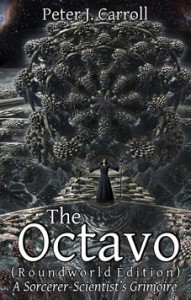
The Octavo
A Sorcerer-Scientist’s Grimoire
Peter J. Carroll
Format: Softcover
ISBN: 9781906958176
£15.00 / US$24.00
Subjects: Chaos Magick
Click HERE for The Octavo / USA
Click HERE for The Octavo / UK
Click here for Kindle UK Edition
Click here for Kindle USA Edition
Every universe potentially has its own Supreme Grimoire containing the spells which define its reality and the magic which you can perform within that reality. In this Octavo we have assembled scattered secrets for a Supreme Grimoire for Roundworld, the universe in which you’re standing.
To this end we have taken some inspiration from Pratchett’s Discworld, and a lot from Theoretical Physics and Practical Chaos Magic.
The most original, and probably the most important, writer on Magick since Aleister Crowley.”
– Robert Anton Wilson. Author of the Cosmic Trigger trilogy.
Review of The Octavo by Dave Lee
This is the second book Pete Carroll has brought out in the last two years, after a number of years’ silence. In 2008, there was ‘The Apophenion’, which was something of a departure towards an overall philosophical position, which we might call chaoism, as distinct from chaos magic. Now he presents us with a new synthesis that aims at a much closer marriage of scientific theory and magic than he, or, to my knowledge, anyone else, has attempted.
The first thing you’ll notice about this book (other than the excellent illustrations) is the subtitle. The reference will be lost on non-Pratchett experts like me; I’ve enjoyed a few of Pratchett’s books and found others a bit twee for my taste. (I have to admit, though, that he shows superb understanding of the thermodynamics of godhood in ‘Small Gods’, and a brilliant vision of the Other in ‘Lords and Ladies.’) Apparently, there’s an Octavo of Discworld spells, and it seems this volume is using the conceit that it’s the Roundworld equivalent in order to show how physics and magic can be combined in two very different universes.
The second thing you’ll notice is the physics. Publishers say that every equation in a book halves the readership, and there are a lot of them in The Octavo*. More, in fact, than in Liber Kaos, but they – at least the ones in the first few chapters – are of a very different kind.
The ‘Equations of Magic’ in Liber Kaos have always been problematic: they dealt in quantities which are not measurable, and probably never will be, like ‘degree of gnosis’ and ‘magical link’. So, they are not really equations, but things that look like equations; what they amount to, at best, is a mental checklist, a summary of what we know about magic so far. With a shorthand like that, all that matters is that it’s easily memorable, and the physico-mathematical symbolism does not help at all.
The equations in Octavo are very different. They are much more ambitious, genuinely cosmogonic in nature, and I suspect they have some very important things to say – to those who understand them rather more deeply than I do. I did get lost for much of chapters 2 and 3 (I only have maths to just short of A-level), but surfaced again at the start of Ch 4, where he compares Discworld and Roundworld physics, and comes out with some pretty profound stuff.
One of the things that’s particularly interesting about Carroll’s science is the way he attributes real physical – or aetheric / shadow-physical – reality to quantities that appear in the fundamental equations of physics. In Liber Kaos for instance the wavefunction in the Schroedinger equation is a measure of a real quantity in shadow-time, rather than a mere mathematical convenience, to be discarded as soon as possible in the course of calculations. No, Carroll finds a home for these misty, despised quantities, integrating them into a description of a magical universe. In The Octavo, he comments about quantum superposition, which is a concept we’re normally just supposed to get our heads round, that it actually has fine detail which makes it much more physically real – the alternative forms of the particle are kind of parked in sideways-time. For me, that is a distinct improvement on the usual way superposition is described.
This realistic use of mathematical entities recalls Galen Strawson’s ‘real materialism’**, as does this (p97):
‘A visualized or imagined event can have a similar effect on the imaginary time plane as the probability function of a material event, because it too constitutes a wave-particle event’.
In other words, ‘thoughts are as real as rocks’, to the real, Strawsonian materialist. Carroll also gives a physico-mathematical reality to Sheldrake’s morphogenetic fields – they are the information contained in the virtual radiations emitted by everything all the time.
I do like the depiction of particles as closed universes (p23), and it’s satisfying to read Theories of Everything, but the problem for the mathematically sub-literate becomes: how can I distinguish the true ones? I’m not sure that Carroll’s doing away with the Big Bang (a dirty job, but someone had to do it) yields a truly more complete ToE than the current one: a steady state model of the universe comes no closer to explaining where everything comes from than the expanding-from-a-point one does, it simply makes it an unaskable question, which is not the same thing. His cosmological explanation of the red shift (the core mystery of cosmology) involves something like a new mechanism for Zwicky’s previously-rejected ‘tired light’ hypothesis, and I have asked a mathematical friend of mine how viable an explanation it is.
Some of my reservations about this book stem from Carroll’s over-willingness to form Laws. Right near the beginning of the book, he has concreted the ‘multiple selves’ model into one. The idea of selfhood as multiple arose out of a very postmodern milieu of thought about what we are, and has proved very useful to magicians. However, it does suffer from a vagueness at its core: it would be a good idea to clarify the difference between personalities and the moment-to-moment sense of selfhood. The former may be usefully thought of as multiple, but the sense of self is always and ever phenomenologically singular. I challenge anyone to describe how it can be sensed otherwise.
This excessive taste for laws surfaces again on p66, where Carroll attempts to prove that there is always ‘ an even number of selves’, with an argument I found so unconvincing I suspect the author is self-consciously preaching to the choir, knowing we’ll indulge him.
My main criticism of the book is that the ‘Equations of Magic’ reappear in Ch6. I’ve said above why they are not equations, but simply tally-sticks; they remind me of Frazer’s useless laws of magic, but with added algebra to put more people off. Has a magician ever told you they’ve helped him or her plan a working?
Their inclusion wouldn’t be such a bad thing if it wasn’t for the very high quality of arguments pursued using real equations in the cosmological parts of the book: to someone who hasn’t been following the maths very closely but can see how the EoMs cannot be real equations, they simply serve to cheapen the value of the other equations and arouse suspicion about their validity. And to use them to derive, via a complicated chain of reasoning, the conclusion that group magic is no more powerful than individual magic is pure tautology, because the only way anyone could get that conclusion would be by building it into the ‘Equation’ in question.
By the way, can we have a straw poll on this? My feeling is that group magic is immensely more effective for some kinds of enchantment.
The final complaint I have is a purely aesthetic one. Sure, it wouldn’t be a bad idea to replace the phrase ‘material base’ with something else, because we do talk about servitors quite a lot. But the term ‘groundsleve’, to my ear, is down in the flooded and odious basement of English, along with ‘staycation’ and ‘bromance’. (OK, I suppose that means I’ll have to come up with one myself.)
Back to a few final words of praise: One of the satisfying things about this book is the way Carroll fills out and brings up to date old ideas, some of which he has developed and used years before. Like the way the good old GPR gets completed into the GCR, a much more symbolically satisfying and complete thing.
Proper weight is given to the Apocalypse, and what wizards can do to help avert the collapse our stupidity has got us into.
I have to make a special mention of the llustrations. If there was an award for ‘best occult book graphics of the year’, then Matt Kaybrin’s would sweep it, with these bold, dark, unusual mixtures of traditional and cyber-art.
In the end, I would definitely recommend this book. It is important, maybe very important, and will stir some interesting thoughts even in the non-mathematically-inclined. Carroll’s basic attitude to mysteries is the only healthy one: not to try and banish them, like the Dawkinsian parascience bunch, or use them to obfuscate, like the religious do. He writes: ‘Mysteries should present challenges, not opportunities for dumb belief.’
*I showed the book to a mentally tough shaman I know, and as soon as he saw the equations, he declared he’d rather chew his leg off than try to understand them.
‘The Octavo is remarkable in the finest sense of the word: a great and indeed unique achievement, making a genuine physics of magic’.
– Professor Ronald Hutton
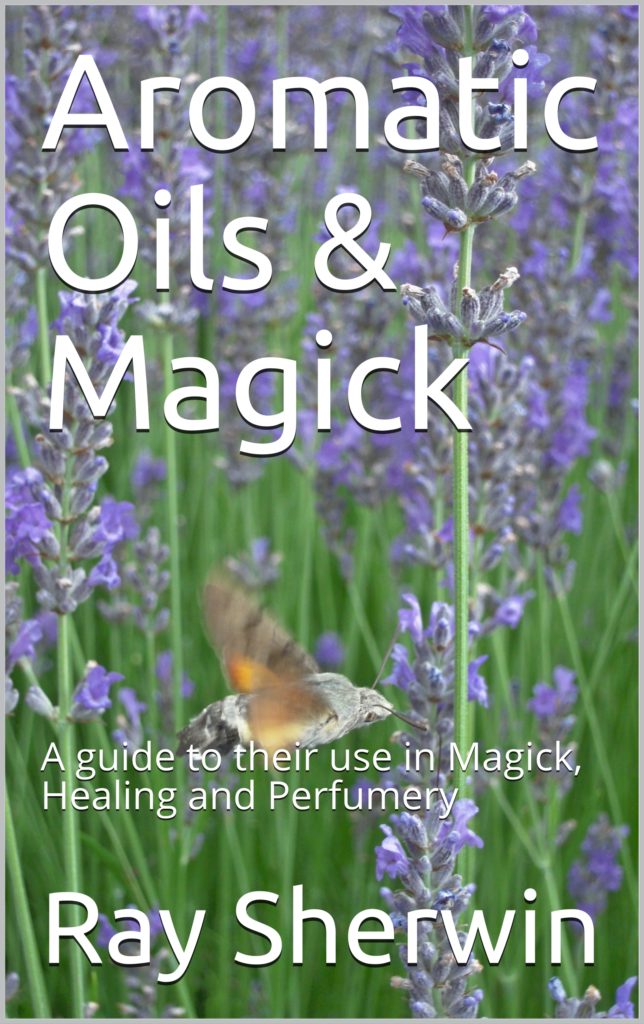
Aromatic Oils
A guide to their use in Magick, Healing & Perfumery
Ray Sherwin
Format: Softcover
ISBN: 978-1906958039
£15.00 / US$22.00
Click HERE for Aromatic Oils & Magick / UK
Click HERE for Aromatic Oils & Magick / USA
Click here for Kindle UK edition
Click here for Kindle USA edition
Discover the Magick of Aromatic Oils 🌿✨ Dive into Ray Sherwin’s unique guide on using aromatic oils for magick, healing, and perfumery! As a renowned chaos mage, Sherwin brings an enchanting blend of wisdom, covering everything from essential oils and therapeutic uses to creating your own perfumes. Plus, enjoy fascinating stories, occult poetry, and insights into the mystical world of scent—from Patchouli and pheromones to witch doctors and ghostly tales.
Awaken your senses and explore the magick within each drop!
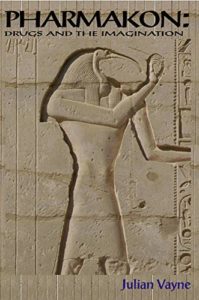
Pharmakon
Drugs & The Imagination
Julian Vayne
Format: Softcover
ISBN: 1869928946
£15.00 / US$24.00
Subjects: Chaos Magick/Entheogens.
Pharmakon / USA & AUS / US$24.00
Click here for Kindle UK Edition
Click here for Kindle USA Edition
Ranging across both published and anecdotal evidence, Pharmakon traces the story of drug use as a means of self-exploration. By examining apparently simple questions such as ‘what is a drug?’, Pharmakon deconstructs and reconstructs the idea of drug experience. Experiences that the author believes are fundamental to the process of self-actualisation and learning.
Naturally though this book discusses all sorts of things that are currently illegal in many nations the author would never wish to encourage anyone to break the Law. Moreover since this book contains information about how human beings can fly like birds, become transformed into animals and explore the farthest reaches of inner space it is, quite clearly, a work of fiction.
Julian Vayne is an occultist who has written on a number of esoteric subjects (witchcraft, the tarot and the sociology of contemporary Paganism). This book is aimed at both the general reader and those who are interested in the use of drugs in a spiritual context.
Delving into areas as diverse as philosophy and neurochemistry, this is a book that in both style and content seeks to invent a new understanding of drugs in culture….
Review
Pharmakon: Drugs and the imagination, by Julian Vayne
The philosopher’s stoned
By Gary Lachman
Published: 24 December 2006
‘Talking about your drug experiences is like talking about your dreams: it may be personally rewarding, but for others it’s a bore. As with dreams, the insights, visions and revelations that accompany some drug experiences can provide new perspectives on your life and help you to “know yourself”. The person on the receiving end of your dope stories, however, more times than not stifles an impatient “So what?” and wonders when you’ll get to the point. This is the paradoxical character of drug experiences: their profound subjectivity is a barrier to communication.
A handful of writers, De Quincey, Huxley, Burroughs and a few others, managed to cross this threshold and master the art of “trip-lit”. But most accounts of psychedelic journeys into inner space boil down to a less than informative “Awesome, man”. This may let us know that the voyage meant a lot to you, but it still leaves us in the dark as to what was so meaningful about it.
Julian Vayne argues that drugs can be an effective tool in self-exploration, and provides some useful theoretical scaffolding in understanding exactly what a “drug experience” is. Vayne argues that the mainstream materialist view of drugs is incomplete, and he makes clear that the chemical analysis of various substances like LSD, Ecstasy, cannabis and other popular items is only half the story. The importance of “set and setting” and our cultural expectations about exactly what a particular drug is supposed to do are equally crucial; our imagination and anticipation about what we will encounter after ingesting a magic mushroom are at least as significant as the psilocybin housed in the fungus itself. Drug experiences, Vayne contends, are learnt. They aren’t simply a matter of an automatic chemical reaction between my bloodstream and the toxin I’ve introduced to it.
He makes a similar point about how the same drug may have very different effects on different people. A lump of hash may lift a Baudelaire into poetic reverie, but the same lump may only sink the rest of us into befuddled sleep. LSD advocates in the 1960s made a similar discovery when it became painfully clear that taking acid didn’t automatically make people more spiritual and enlightened. The trip, good or bad, is as much in ourselves as in the drug.
Although Vayne has written several books on occult subjects, the occult or magical sensibility informing the book is curiously faint. The tone is academic, and a great part of the book is devoted to the mechanics of how drugs interact with our neurochemistry. He’s also at pains to anchor drug experiences in the post-modern discourse of transgression. This makes for a text in which Derrida turns up almost as often as Aleister Crowley. It’s refreshing to find occultism rubbing shoulders with other viewpoints, but the narrative is sometimes burdened with digressions on the Derridian “trace” and other notions.
Vayne’s most interesting insights come with his discussion of autism and schizophrenia as two poles of human consciousness: one an impenetrable contraction of the ego, the other a debilitating exposure to the chaos of the unconscious. Vayne makes a good argument that, rather than exceptional conditions, autism and schizophrenia are the extremes between which our ‘normal’ consciousness fluctuates; drugs for him are a means of compensating for imbalances between the two. Like many writers on mystical subjects, Vayne sees western culture as veering too much into an ego-bound autism. Hence the virtue of hallucinogens in providing a kind of controlled schizophrenia to even things out.
There are also some howlers. Theophile Gautier and the other members of the Club des Haschischins ate their cannabis, they didn’t smoke it. Julian Jaynes was a psychologist, not a historian. And I imagine that the “occultist W B Leadbeater” is an amalgam of W B Yeats and C W Leadbeater. If you’re arguing that drugs can be a tool in self-actualisation, it’s a good idea not to provide material for jokes about how stoned you were when you put your book together.
From Mandrake Speaks #100
‘A well researched and informative look at a variety of popular and not-so-well-known drugs. He deals with how they interact with our minds and bodies both chemically and psychologically, and how we perceive substances on a personal and society-wide scale. The similarities discussed between some drug experiences and some mental illnesses may lead to different viewpoints on both. Liberally sprinkled with folklore and anecdotes, Pharmakon examines the use of drugs in self-exploration employing a knowledgeable, yet down-to-earth approach that’s interesting and readable.’
More reviews see Erowid and Occultbooks
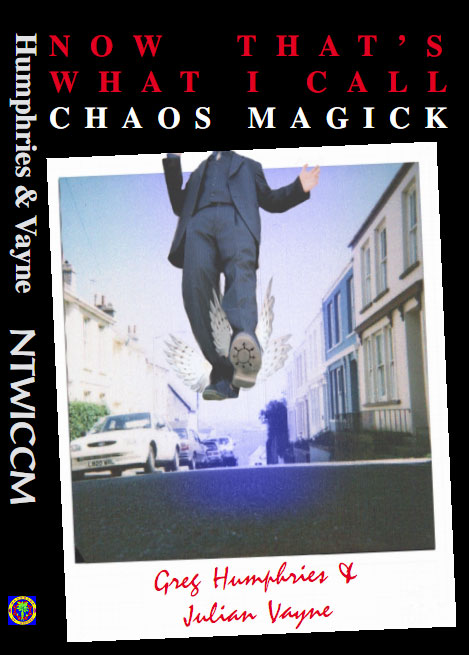
Now that’s what I call Chaos Magick
Greg Humphries & Julian Vayne
Format: Softcover
ISBN: 1869928741
£15.00 / US$24.00
Subjects: Chaos Magick
Click here for Kindle UK edition
Click here for Kindle USA edition
”Now That’s What I Call Chaos Magick gives the beginner and experienced practitioner alike a modern, 21st century view into the powerful and often misunderstood magical current called ‘Chaos Magick’. Written in a clear and easily accessible style it examines the theory behind many techniques used in magical, artistic, religious and scientific systems of thought; then links and applies them towards desired goals. Separated into two volumes the book can be used by the reader as a workbook with rituals, techniques and exercises to be followed, as a window into contemporary magical thought at the turn of the century or simply as a rollercoaster of a good read! However you choose to use it, ts book will leave you feeling positive, inspired and ready to apply any of the methods presented to your own life.”
REVIEW
”we cannot recommend this book to anybody who is frightened of magic, of self-discovery or of adventure; to anybody who wants ritual experiences that are absolutely risk-free and have a guaranteed result; to anybody whose concept of ceremony depends on the provision of scripts for all participants, carefully typed out and enclosed in polythene wrappers; to anybody who believes that magical practices should follow set traditions, without mixing ideas from different ages or cultures; to anybody who believes that human beings are firmly subordinated to deities and must do their will; and to anybody whose favourite words of condemnation for others are ‘irresponsible’ or ‘self-indulgent’. Above all, I cannot recommend it to anybody without a sense of humour. Anybody else should love it: it provides an experience of ritual that is energetic, fresh, investigative, exciting and fun, in a completely individual way.’
Professor Ronald Hutton
MORE REVIEWS
”If you think ritual magic is about drawing pentagrams in blood and sacrificing your neighbour’s cat – if, that is, you think about it at all – this book will come as a surprise. Not too many books on magic – or magick, the authors’ preferred spelling, which the notorious Aleister Crowley adopted to differentiate the true art from tawdry prestidigitation – boast of a ritual to “stop time” which involves baking cookies. Or suggest making a talisman into a fridge magnet. Or advise a game of Twister to set the mood. Or link Jean Luc Godard, Jacques Lacan and Buffy the Vampire Slayer to acquiring the Knowledge and Conversation of your Holy Guardian Angel. It’s also true that not many envision the dark Hindu goddess Kali as P J Harvey wearing a T-shirt that says “lick my legs” or offer exercises to achieve multiple orgasms – male and female.
If this sounds like a spoof, that’s understandable: while the authors are serious and dedicated practitioners, they have the key occult insight that when humour is lacking, all magic fails, and they take a decidedly light-handed (or, in their terminology, “empty-handed”) approach to what can too often be a dreary, sanctimonious affair. The “chaos magick” of the tide emerged in the late 1980s, when, like practically everything else, occultism was infected with the post- modernism bug. Jettisoning the cumbersome apparatus of traditional practice, and blending as many styles and belief systems as desired, chaos magick is about using your imagination and whatever is at hand in order to “engage with mystery.”
Devotees can find its origin in the work of the 19th-century French ex-Socialist-tumed-Kabbalist Eliphas Levi, who boiled down the real machinery of magic to the will and imagination. Where earlier mages fixated on a neurotic obsession with the minutiae of demonic names and the exact times to invoke them, Levi argued that all this was merely a means of focusing the magician’s own powers. Chaos magicians took Levi’s lead and ran with it: they’re more concerned with exploring their own creativity than with getting it right, and would rather invent their own spirits than lose sleep worrying about the appropriate one to petition. This book is a collection of rituals, accounts and reflections on how magick can invest any humdrum life with some new perspectives and, above all, fun.
Although clearly not for everyone, unlike many books on the subject, this one’s readable and the authors have a knack for the catchy phrase. “Love,” they tell us, “is as ubiquitous as the curvature of space.” In one account of a ritual invoking the aforementioned Kali, the participants call out “Hear us oh pork chop champion of the oppressed.” There’s also a personal tone that’s appealing. These magicians come across as very likeable chaps who are as concerned with having a family and a nice home as they are with exploring the profundities of existence. Does it work? Well, as any chaos magician would answer “There’s only one way to find out.”
Gary Lachman, 17th, JULY, 2005, in THE INDEPENDENT ON SUNDAY.
Gary Lachman has written many popular books on occulture, including, The Dedalus Occult Reader: The Garden of Hermetic Dreams published by Dedalus.
—–
Review from Danny Lowe on Phil Hine’s website
”It’s been over 25 years since the first Chaos Magick book was published (Pete Carroll’s Liber Null – even if the first edition didn’t use the term). It’s a current which has been hailed as revolutionary, and pronounced dead several times (again in this book, in fact). Can a magical approach of such uncertain status have anything new to say, long out of its adolescence and stumbling towards middle age? I guess this book is fairly placed to answer that question.Unusually, this is two books in one, with sections from Julian Vayne and Greg Humphries respectively. I felt this was the first strength of the book, as multiple authors suggest a diversity of viewpoints, avoiding the trap of asserting a single, solitary “one right way”. The first section begins with an erudite introduction to the last century or so of Western Magick taking in Eliphas Levi, Crowley, Austin Spare and the innovations of the Chaos current. This is followed by four accounts of the authors’ involvement in several different rituals. As might be expected from a chaos magician, an eclectic variety of approaches is given, with material deriving from Voodoun and Tantra alongside some more freeform approaches. However, surprisingly (depending on whose books you’ve been reading) we’re given more than raw technique. Each of the sections is reasonably lengthy and more than just a “ritual rubric” – importantly, we’re given context, in both the background and results of the rituals entered into, as opposed to a “now do this”, nuts n’ bolts approach. The “backstage” of these rituals takes in variously film-making, a punch-up, chats with kids and contemplations of mortality and fatherhood, amongst other things.
The second half of the book comes has 3 sections – Abstract, Theory and Practicum. Again, the personal and descriptive style comes to the fore, weaving an account of a love affair in with a description of a long term evocation. This style – again, the context – in both halves of the book, felt to me very much what it is like to actually stop reading and get down to doing magick – to take those tentative steps, and eventually to allow yourself to be caught up, inspired. To me, this is the real strength of this book, magick is shown as an involving, creative act, something that touches all areas of life, all concerns – it doesn’t just stop at the edge of the circle.
The remaining two sections of the books second half give “bones” to the descriptive “flesh”, giving details of theory and technique respectively. With regard to the former, I particularly liked the authors’ description of the act of storytelling – addressing the ways in which we weave narratives around ourselves continuously and suggesting that we can step into new, empowering stories. The “technical ” section gives details of various ideas borrowed and plundered, in true chaos magick style – NLP, the works of Mantak Chia, spontaneous art and the Holy Guardian Angel. “Plundered” they may be, but here I feel that they add up to more than the sum of their parts. This section contains much that could be bent to one’s own design.
Now, I didn’t like everything about this book – at moments I found the style a bit …breathless, and not all the rituals were to my taste – but this is a matter of just that, taste. A more serious criticism, one that can be applied to chaos magick in general, arose when reading the section on Tantric ritual – I wondered, was the symbolism here just a cool sounding gestalt, or had it been lived, felt and thought through? I’d argue for the latter over the former anytime. It’s this kind of relentless eclecticism in CM that can feel like a lack of engagement, a kind of frothy post-modern shallowness. However, turning back to the introduction, I was pleased to find this statement, regarding contemporary practice: “depth and diversity seem to be the predominant approach rather than polymorphous paradigms with a few key principles”. This is a sentiment I heartily agree with. To be eclectic does not necessarily equate with being superficial.
Overall, then, I found this an enjoyable and rewarding work with much to inspire, imitate (and rip off). I was left unsure whether chaos magick was alive or dead (and to be totally honest, I don’t really care).- however, I am sure that people are continuing to practise exciting and creative magick, under whatever banner.”
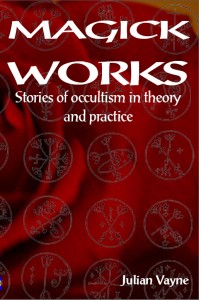
Magick Works
Julian Vayne
Format: Softcover
ISBN: 978-1869928-469
£15.00 / US$24.00
Subjects: Magick/Chaos Magick.
Magick Works / USA & AUS / $24.00
REVIEW
”Many years ago your editor had a short conversation with the author of this book at the Aquarian Festival in London when he was still a teenager. He was asking how he could join a coven or a magical lodge and my advice was that he had to wait a few years. At the time some people dismissed him as a precocious brat, but the passing of time has proved that judgement wrong.
His latest book is a selection of ‘personal experiences, insights and challenges woven throughout with the golden thread of magick’ and they are mostly based on the talks he has given over the years since he was a wunderkind. They range from Crowley as a shaman to English witchcraft and macumba, green politics and druidry, to drugs and magick. Highly entertaining stuff.”
Magick Works by Julian Vayne,
Reviewed by Mike Howard in The Cauldron,
issue 131, February 2009.

Click Here for CHAOTOPIA! / UK
Click here for Kindle UK edition
Click Here for CHAOTOPIA! / USA
Click here for Kindle USA edition
Chaotopia!
Dave Lee
Format: Softcover
ISBN:
£15.00 / US$26
Subjects: Chaos Magick
–
‘Once one is fairly competent at practical sorcery, there is little of importance that remains to be said or read about the subject; the magician at this point tends to emphasize inner development in his work. It seems to me that Chaos Magic itself has reached this point; the basic ideas needed for anyone to construct his or her own system of sorcery and to hone their skills are already covered by the available books. What has been lacking so far, is a Chaos magical approach to the investigation of the ecstatic states that underlie magical gnosis. This book, rather than trying to provide yet another slightly different flavour of Chaos technique, takes as its starting point the relationship between ecstasy and magic; between Chaos Magic and Chaos Mysticism, if you like.’ from Chaotopia! page 8
Chaotopia! is neither Utopia nor its opposite. It is what Austin Osman Spare called ‘the chaos of the normal’, seen through an illuminated eye, the eye of the sorcerer.
Chaotopia! includes updates and evaluations of techniques in Chaos Magick and an exploration of ecstatic states in relation to both magick and mysticism.
Also chapters on:
Wealth Magick/Conflict and Exorcism/Sex Magick/Body Alchemy and Healing/Magick and Physics/Chaos Illumination/Spirits/Aeonics
Praise for Dave Lee’s Chaotopia!
‘A highly intelligent book by a leading Chaos Magician which will broaden and deepen Chaoist debate, theory and practice.’
– Peter J. Carroll
MORE REVIEWS
”Chaos magic has come magician and NLP maven Lee. This is not a primer or grimoire; instead, the book puts chaos magic in its conceptual context, explaining the theoretical and metaphysical vistas which have underscored the art’s development since its inception under the asgis of the late, great Austin Osman Spare.
It allows us to see chaos magic äs a form of autonomous mysticism; not so much a syncretic exercise in cosmic tourism äs a balancing attempt to make sense of what arrives in one’s head. This makes it more democratic than the intimidating acolytism of learned magic in the European tradition. Chaos magic rests on the principle that the practitioner can apply belief at will, rather than surrendering to any particular paradigm (thus the slightly wrenched meaning of ‘paradigm stuft’ in chaos practice). It also assumes that altered states permit a powerfui interaction with one’s own centres of power, and äs a result, chaos magicians experiment with psychotropic techniques, including drug use, meditation, hyperventilation and extreme exercise.
Lee shows us the intellectual underpinnings of a practical System, without rendering the art, or his discourse on it, abstract or arch. He sets out the theoretical contribution of Robert Anton Wilson et al, explains Aeonics, and the trajectory of its distillation from the baroque theatre of angelology, and expounds the vital notions of chaos and Illumination, äs Spare originally conceived them, and as practice has altered and matured them.
This is not for the beginner in chaos magic, but it is a good guide for the observer with a grounding in the history of European magic, and a grasp of its cultural milestones. If you ever wondered why magicians do what they do, it’s because it works. If it didn’t, the tradition would have died out with the birth of science; it hasn’t and is enjoying a fertile period. Chaos magic is central to the continuing health of magical traditions, and writers like Dave Lee are central to that influence. His observation that accomplishe magicians concentrate on inner development ties chaos magic firmly to the Spiritual traditions of alchemy, and suggests that the development of chaos magic as a Spiritual endeavour has a long future, as well äs a brilliantly energetic past. Great stuff.”
Review from Sly Delaney – FT214 – Fortean Times verdict 8.
—-
”Chaos Magick has been the “sorcery” of choice for some years; indeed it is feared by many to have become way too trendy. There have been many books coming onto the market supposedly outlining the Chaos Magick vision which seem to confuse incoherence with mystification.. However, I am very pleased to say Chaotopia! is not one of them indeed I consider it one of the better books on Chaos Magick I have read in quite a long time. It was originally published in 1997 but includes a very succinct but updated introduction which gives us a snapshot of the basic principles of Chaos Magick and how it works.
In many way I found Chaotopia! a real “debate starter” it covers so many subjects, all of which demand further thought, investigation and discussion, for a relatively small tome of 200 odd pages there is little “padding” and lots of content, no wasted words here ! There are carefully placed “interludes” which include all sorts of exercises, meditations and rites in addition to practices throughout the work so Chaotopia offers a solid balance of theory and practice.
Lee outlines a theory of magick based on Leary and Robert Anton Wilson’s model of Eight Brain Circuits; this is quite an intriguing model and does offer quite a lot of insight into how magick work. He also outlines later in Chaotopia! Carroll’s model of Aeonics and cultural evolution. For the budding Chaos magician I would suggest comparing these with such developments as Spiral Dynamics and Ken Wilber’s Integral Model, each has its benefits and drawbacks. The Eight Brain Circuits are more practical (i.e. psychedelic), while Wilber’s model is certainly more cerebral. Aeonics has a magical foundation but I think lacks some integration into the bigger picture which Wilber’s offer. As you can see there is a lot to think about in this work ! Every chapter I read made me what to read more, think more and practice more….
There is a very insightful chapter on wealth and money, a subject looked down on by “high” magick and yet so imperative in today’s busy and demanding work. There is a great section on cursing and exorcism which avoids the paranoid mood so often found in works on “psychic self defense” and offers down to earth guidelines and well as techniques if you really need them.
The section on sex and magick is impressively without pretense and covers all sorts of issues ranging from the use of sexual fluids to S & M. I especially found the section on sex and smell impressive and felt Lee explored area’s ignored by other works.
The theoretical chapter on Magick and physics is a real intellectual stimulator. It offers a new theoretical foundation for magick as found within the Bose-Einstein Condensate. It will trigger lots of discussion and debate.
I could continue chapter in this way. There is so much packed in here. Chaotopia! is how magical books should be written. No padding, no BS, no wasted space, lots of important information, practice advise and hints. An avoidance of pretense and an openness which leaves the reader eager to go out and learn more and practice more.
Dave Lee, Thank You !”
Review in Living Traditions
—–
You enjoyed reading Bright from the Well and Chaotopia! and would like to know more about the latest techniques, articles, resources, workshops, news and events from the author, then check out DAVE LEE’S CHAOTOPIA WEBSITE www.chaotopia.com
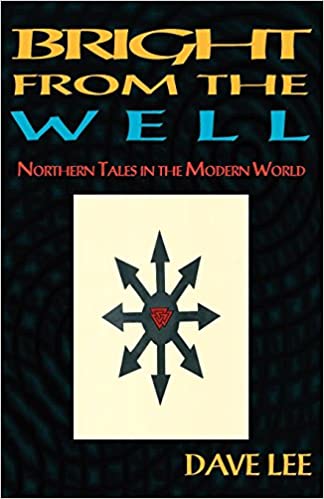
Bright from The Well
Northern Tales in The Modern World
Dave Lee
Format: Softcover
ISBN: 978-1869928841
£15.00/ US$22.00
Subjects: Northern Tradition/Chaos Magick.
Click Here for Bright from The Well / USA
Click Here for Bright from The Well / UK
REVIEWS
Attentive readers might have noticed me banging on about the collective & individual fading of memory, & the need to imagine an alternative language to talk about radical social change, entailing a re-memberance, or putting together of scattered parts strewn over a landscape of fragments.
Into my hands recently came a new book by Dave Lee, Bright from the Well – Northern Tales in the Modern World. Mandrake of Oxford (2008). It’s a retelling & reimagining of the creation & social origin myths of the Northern European tradition, including the Völuspá, & Rigsþula (Rig’s Tale). Comprising five short stories & five essays, it’s an odd but compelling read, combining a reworked & updated phenomenology of the myths with vividly told stories set in the contemporary world of would-be sorcerers & Chaos Magic.
Those with a suspicious turn of mind wrongly might detect a whiff of the Thule Society, & the romantic/reactionary projects dreamed up by the likes of W. B. Yeats & D. H. Lawrence, which often resulted in psychosomatic afflictions of the right arm. But Dave Lee is no New Ager, sharing my view that these are people with too many easily acquired beliefs to spend, who couldn’t think their way out of a paper bag. Think rather of the imaginative legacy & radical engagement of William Blake. Great stuff, ideas sparking off in all directions.
Klaus Bubblehammer, Bubblehammerblog
bubblehammerblog.blogspot.com/2008/11/recommended-reading.html
–
Bright From The Well
– Northern Tales in the Modern World
by Dave Lee
Review by Akashanath
A common difficulty for magicians moving from one tradition to another is reductio ad nauseum. With little effort, it is easy to nail the symbolism of one’s latest trip onto the pre-existing crucifix of one’s earlier experiences, eventually reducing every opportunity for novelty to a stale repeat of one’s preconceptions. Chaos Magick has often fallen into this trap, its dogma of ‘non-dogmatism’ leading adherents to strip belief-systems to their ‘essentials’, sometimes to the point where they lose much of their beauty and function. At the opposite extreme one can simply be overwhelmed by the strangeness and unfamiliarity of a new world-view, and fail to find a point from which to begin one’s assimilation. The Norse and Saxon myths, with their fragmented, archaic language and almost prehistoric themes, can often evoke this type of response. In his newest book, Dave Lee lithely navigates the pass between these twin peaks, taking time to pause and explore the dilemmas, or muse on them in the form of short fables. People expecting a book about the runes will not be disappointed. Those hoping for further expositions on the subject(s) of Chaos Magick will find plenty of interest. But for me where Bright From The Well comes into its own is as a series of reflections on dilemmas that will be familiar to many 21st century occultists.
For example, Chapter 5 is entitled “The Magician In and Against The World.” It’s essentially an analysis of the twin functions of the magician as anarchist, challenging the false autocracy of consensus reality, and the magician as priest, strengthening social traditions by helping the laity to connect them to their spiritual and cosmic sources. Within his complex analysis, Dave grapples with magicians’ tendencies towards transcendence on the one hand and immanence on the other. This rang loud bells for me; in my magickal quest I have often lurched from mind-bending hedonism to ruthless ascetic austerity and back again, struggling to marry my hungers and drives with some arbitrary construct of ultimate purpose. Dave also concludes that some sort of unification is necessary, describing this in terms of the intermarriage of the Vanir and the Aesir, the two Northern pantheons who exchange hostages somewhere near the beginning of time. Dave’s exegesis interprets the former as gods of immanence and the latter as deities of transcendence and consciousness (though not exclusively so). In a story from Snorri’s Prose Edda, Dave tells us how the Aesir (in the form of Odin) and the Vanir (in the form of Tyr) trick the Fenriswoolf (primal chaos) into allowing itself to be bound, creating the ordered universe that is a necessary precondition for human society and hence both esoteric and exoteric religious practice.
Students of Tantrika may find parallels here, and indeed Dave makes passing reference to the left and right hand paths. In many contemporary Hindu icons the transcendent Shiva is depicted sitting on his mountain, meditating and smoking Ganja, largely disinterested in the world. One myth tells us how the goddess Kali once went on a killing spree. Initially invoked by men seeking support in their war with the demons, Kali has lost sight of her original intention in an orgy of destruction. With all the demons slain, she turns her unstoppable fury on her former allies, slaughtering them with her many arms. Summoned from his mountain, Shiva is intrigued. Lying in front of her with his c**k erect, he looks up, turned on by her warped face and blood-stained body. Gradually her lust for killing turns into a different kind of lust, and the two deities begin to f**k. Separate from one another, they are aimless, functionless. In unity, Siva (transcendence) gains the capacity to manifest in the physical world, while Kali (immanence) transmutes her destructive power to generative.
Some of the other sections completely obviate the need for parallels by speaking directly to the magician’s experience. In Chapter 7, the author recounts a fascinating and credible list of magickal anecdotes spanning over 20 (and perhaps closer to 30?) years of workings, grouped into a rough typology of function. Several chapters take the form of stories, some obviously derived from Nordic originals, others less so. The style is engaging and entertaining, not laboriously educational or annoyingly whimsical, and each is short enough to be knocked off quickly (or omitted altogether) should it not be to the reader’s taste.
As well as re-telling stories from the northern traditions and presenting a novel method of working with the entities described as dwarves, the book contains a complete rune poem in English. Although it probably wouldn’t stand alone as a manual of rune magick, anyone genuinely interested in the subject could probably learn something new. The main strength, for those interested in Nordic traditions, will probably be for those looking for another perspective from which to triangulate dry, historical academic texts on the one hand and the often pedantic dogmatism of modern Odinists on the other. Overall, as the title implies, the collection is refreshing and inspired. Well worth a read!
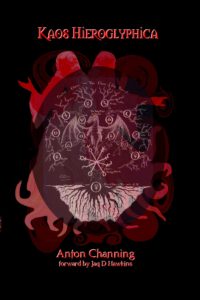
Kaos Hieroglyphica
Anton Channing
Format: Hardback Case Laminated.
ISBN:
£19.99/US$35
Subjects: Chaos Magick
–
‘Mr Channing plays Trotsky to my Lenin, and Luther to the most holy of Chaos Orthodoxies.’ – Pete Carroll
In the year 1564, Dr John Dee published his work, Monas Hieroglyphica. Its central symbol represented the unity which was the gnosis of the monotheistic aeon.
Now over four hundred years later, Anton Channing has published his long awaited debut work Kaos Hieroglyphica, within which he expounds a new symbol, the Kaos Hieroglyph. This symbol represents the plurality and freedom of the New Aeon. This work of magical alchemy draws on such diverse material as Thelema, the Chaos Current, the Maat Current, Timothy Leary, Witchcraft, Paganism, the Hermetic Tradition, Taoism, Shamanism and the author’s own Pineal Gland.
The Kaos Hieroglyphica offers the reader interpretations of Hermetic symbolism in a way that is both insightful and relevant to New Aeon Magic.
Contents
Forward by Jaq D Hawkins
0. Introduction
1. The Cybermorphic Kaosphere System
2. Pure Magick
3. Duality
4. Elemental Magick
5. The Eight Colours of Magick
6. The Kaos Hieroglyph
Appendix A – Aeonics
Appendix B – Eight Circuit Model
Appendix C – Training Programme
Appendix D – Divination
Appendix E – Kaobala
Peter J Carroll. December ’04:
Infamy! Infamy! Anton has surely got it in for me, in these two hundred pages of relentless revisionism. Here we see heresy of the most outrageous kind, Mr Channing plays Trotsky to my Lenin, and Luther to the most holy of Chaos Orthodoxies.
Methinks I may excommunicate him with extreme prejudice for revealing the secret asymmetries and imbalances in my Eight Magics which have propelled me to global notoriety, undeserved riches, and domination of the metaphysical realms.
May Baphomet dam his loins and may Eris make his balls explode, for he hath proposed a counter-reformation back into the antique concepts of soul, ‘being’, and symbo-realism.
He even proposes, and mark this, an alternative order completely lacking even the most basic dominance hierarchy, terrible secrets, and bloodcurdling initiation rites, yet he seems such a reasonable guy.
I have arranged to have a drink with him to see where it all went new-age shaped.
In the meantime read the book, I found it both provocative and entertaining but I have to warn you about the shockingly high ‘is’ count. That in itself provides a key to the symbolistic conceptual style of the author.
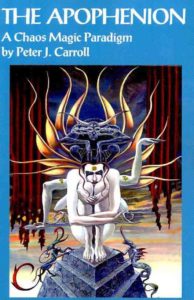
The Apophenion
A Chaos Magic Paradigm
Peter J. Carroll
ISBN: 978-1869928650
Format: Softcover
£15.00 / US$24
Subjects: Chaos Magic
Click HERE for The Apophenion / USA
Click HERE The Apophenion / UK
Click here for Kindle UK Edition
Click here for Kindle USA Edition
From the Author
“My final Magnum Opus if its ideas remain unfalsified within my lifetime, otherwise its back to the drawing board.
Yet I’ve tried to keep it as short and simple as possible, it consists of eight fairly brief and terse chapters and five appendices. It attacks most of the great questions of being, free will, consciousness, meaning, the nature of mind, and humanity’s place in the cosmos, from a magical perspective.
Some of the conclusions seem to challenge many of the deeply held assumptions that our culture has taught us, so brace yourself for the paradigm crash and look for the jewels revealed in the wreckage.This book contains something to offend everyone; enough science to upset the magicians, enough magic to upset the scientists, and enough blasphemy to upset most trancendentalists.”
The Apophenion cover artwork by David Gough www.davidgoughart.com
”Apophenia is the experience of seeing meaningful patterns or connections in random or meaningless data. The term was coined in 1958 by Klaus Conrad,[1] who defined it as the “unmotivated seeing of connections” accompanied by a “specific experience of an abnormal meaningfulness”. Source Wikipedia
Praise for Peter J. Carroll’s works
“The most original, and probably the most important, writer on Magick since Aleister Crowley.” Robert Anton Wilson, author of the Cosmic Trigger trilogy.
“Magicians feared they had lost Him to the world of Theoretical Physics, but Zarathustra has come down from the mountain. The Apophenion is spoken – and proves the wait was worth it. Religion starts the hunt for Meaning, and with science Meaning is killed and served up as Truth. So we need magic, sowing the seeds of Meaning in everyday events, and we need art to cultivate them to public awareness. Thus does Apopheniareveal how to bring back meaning to our diminished lives.” Lionel Snell, Aka Ramsey Dukes, author of SSOTBME.
REVIEWS
THE APOPHENION
by Peter J. Carroll
‘Framed as the outpouring of insight generated by the novel Goddess ‘Apophenia’, Pete Carroll’s new work is a real gem. Coming from a science background, this is his attempt to create a falisfiable model of why the universe looks the way it does, and just why magick can operate successfully.
In the inimitable Carrollian style we have come to know and love, our author sets out to demolish the edifices of being, consciousness, causality, the big-bang and more. In toppling these ontological Titans Pete discovers a universe of panpsychism and intense meaning.
If nothing else this agrees with my own views and is therefore a Good Thing. Pursuing this process through the scientific style of exploration means that quantum physics, special relativity et al show up pretty frequently in the text. If you buy this book expecting lists of planetary correspondence and ritual-by-numbers instructions you’re going to be disappointed.
However this doesn’t mean that this is all physics and no esoterica. Rather the point is that the reading of the universe that the author presents is suffused with magick. (Nevertheless there are some reassuring illustrations of occult entities and one explicit ritual – a rather lovely evocation of the Goddess Apophenia herself).
My reaction in reading this book was one of excitement. The suggestions that Pete advances tickle the mind delightfully. Certainly this isn’t Liber Null. It’s not a manual of techniques but instead concentrates on theory, yet that doesn’t make for a dull read. The theorisation presented here can light the touch paper of a hundred disciplines: cosmology and magick for sure but also Fortean studies, ethnography and especially neuro-biology.
Algebra explodes across the appendices of the book scattering the non-mathematicians towards the Epilogue where things are nicely rounded off in laypersons terms. The truth may well be that we live in vorticitating hypersphere with three dimensional time that, as the author beautifully asserts, “…invites us to become apprentice gods.” The very fact that I can now say ‘vorticitating hypersphere’ and know what that means is a testament to the authors explicatory powers.
The final and perhaps most wonderful thing about The Apophenion is how it demonstrates the development and maturation of Pete Carroll’s earlier writing. If nothing else this stands as a testament to the work of an individual (or perhaps conspiracy of selves!) who’s magick really does seem to work.
Eight chaospheres out of a possible eight!’
– Julian Vayne